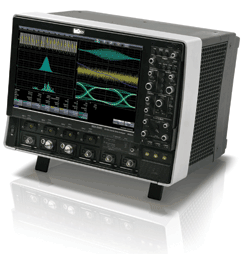LeCroy’s WaveMaster 830 Zi 30-GHz digital scope
If there’s one instrument that’s essential for electronic design, it’s the oscilloscope. The scope lets engineers see the invisible, understand how theory becomes reality, and watch how electrons are behaving in the actual circuits they design.
Today, designers are commonly working at much higher frequencies than they were just a decade ago, and their designs need to get to market much faster than ever before. Thus, the pressure has been on for instrument suppliers to deliver scopes with higher bandwidths than ever before. Further, the scopes cannot rely on repetitive signal sampling, since such techniques can miss infrequent but significant glitches. They need instruments, referred to as real-time digital oscilloscopes, that can capture the complete signal in a single pass.
Thus, for engineers working on developing, say, the latest high-speed bus architectures common to most of modern electronics, the introduction of the WaveMaster 830 Zi digital oscilloscope by LeCroy (Chestnut Ridge, NY) last January was most welcome. It is the first scope to achieve a real-time bandwidth of 30 GHz, the highest real-time bandwidth available in the world.

To achieve 30-GHz real-time performance, the digitizing system in the 830 Zi uses technology called digital bandwidth interleaving (DBI). Previously patented by LeCroy. DBI employs RF hardware to down convert the high-frequency bands of a signal, then passes both the high- and low-frequency components simultaneously through separate front-end amplifiers and ADCs. The two components are then re-combined using digital signal processing.
The advantage of this method is that the front-end amplifiers are always operating comfortably in their rated frequency range, and there is no impact on electrical noise or signal fidelity. Thus, the basic 16-GHz bandwidth performance of the silicon-germanium signal-conditioning components can be doubled to 30 GHz while maintaining the high signal-fidelity and low-noise performance.
Sample rate and memory are likewise doubled. The bandwidth and sampling rate, combined with a deep acquisition memory, allow large blocks of data to be acquired in real time for signal processing and detection of the data bits and computation of bit error ratios.
LeCroy had developed DBI for earlier scopes in its line, but wasn’t certain how quickly they would be able to ramp it up to achieve 30-GHz performance. It was therefore a happy day when early tests of the enhanced circuitry proved a resounding success.
With the WaveMaster 830 Zi, LeCroy became the leader in high-bandwidth real-time scopes, surpassing its Coloradoan and Oregonian rivals. The significance of achieving such performance is underscored by the fact that those competitors have not been able to field a competitive product in the past year.
Richard Comerford
Advertisement
Learn more about Teledyne Lecroy





